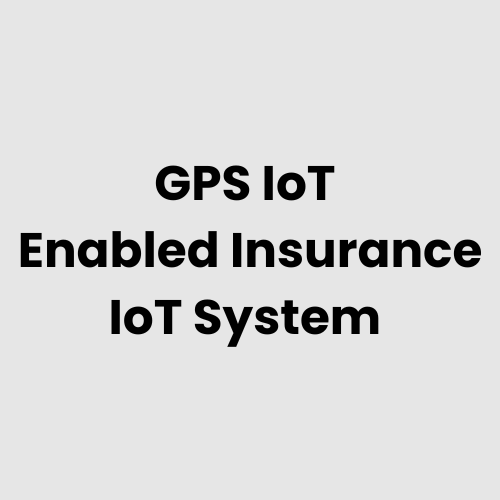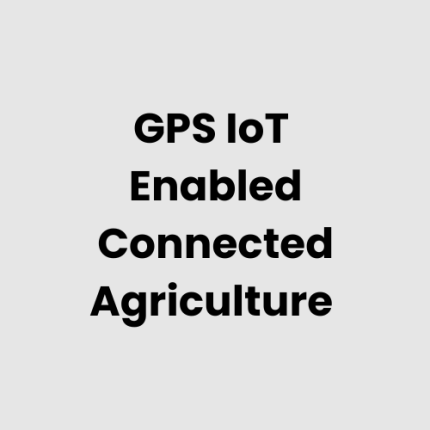Description
Technical Architecture of GPS IoT Enabled Insurance IoT System
The GPS IoT Enabled Insurance IoT System incorporates multiple layers of technology to offer real-time data collection, processing, and management. The system integrates GPS sensors, communication interfaces, and cloud or local data storage. Real-time tracking of assets, vehicles, and individuals ensures that insurance companies can assess risks accurately and improve claims management. Data from sensors is processed by an embedded edge computing system and transmitted via secure communication protocols to the cloud, or local servers for further processing and analysis.
List of Hardware for GPS IoT Enabled Insurance IoT System
- GPS Sensors: To track assets, vehicles, or individuals in real time.
- IoT Gateways: For local processing and routing of data to central servers.
- Edge Computing Devices: To process and analyse data locally before transmission.
- Communication Modules: Including Wi-Fi, LTE, 5G, or Zigbee for secure data transmission.
- Cameras and Imaging Devices: For real-time monitoring and incident reporting.
- Environmental Sensors: To monitor weather, temperature, and other conditions relevant to insurance claims.
- Power Supply Units: To ensure uninterrupted operation of sensors and devices.
- Smart Wearables: For monitoring health, safety, or location of policyholders.
- Local Servers: For businesses choosing to store and process data onsite.
- Mobile Devices: For field agents to interact with and update data.
Physical Placement Considerations of Hardware for GPS IoT Enabled Insurance IoT System
- GPS Sensors: Should be placed on insured assets, vehicles, or property for accurate tracking. Ensure they are weather-resistant and tamper-proof.
- Cameras and Imaging Devices: Position them in strategic areas such as parking lots, facilities, or properties to monitor risks and incidents.
- Environmental Sensors: Install in areas where weather or environmental changes can impact insurance claims (e.g., warehouses, vehicles, outdoor assets).
- IoT Gateways: Should be centrally located for efficient data aggregation from multiple sensors and devices.
- Edge Computing Devices: Positioned closer to sensor locations to reduce latency in data processing and increase operational efficiency.
- Power Supply Units: Place these close to IoT devices to ensure continuous operation and ease of access for maintenance.
Hardware Architecture of GPS IoT Enabled Insurance IoT System
The architecture of the GPS IoT Enabled Insurance IoT System is composed of several layers:
- Sensor Layer: Includes GPS sensors, environmental sensors, cameras, and wearable devices. This layer collects raw data from the physical environment and transmits it to the next layer for processing.
- Edge Computing Layer: Localized devices process data near the sensor source, performing pre-processing, filtering, and aggregation. This layer reduces the burden on central servers and enhances real-time decision-making.
- Communication Layer: Secure communication protocols (Wi-Fi, LTE, Zigbee, etc.) are used to transmit processed data from the edge devices to centralized servers or cloud platforms for further analysis.
- Data Management Layer: This layer stores, processes, and analyses the incoming data using cloud or on-premises infrastructure, employing advanced analytics for decision-making.
- Application Layer: Interfaces with insurance providers, offering dashboards, risk analysis reports, claims management, and real-time monitoring tools.
Deployment Considerations for GPS IoT Enabled Insurance IoT System
- Scalability: The system must be scalable to accommodate various types of insurance applications, from individual property insurance to large-scale fleet management.
- Network Connectivity: Ensure reliable communication infrastructure (Wi-Fi, LTE, 5G) for real-time data transmission between devices, gateways, and servers.
- Data Security: Implement encryption and secure communication channels to protect sensitive insurance data, ensuring compliance with industry regulations.
- Integration with Existing Systems: The IoT solution should seamlessly integrate with existing insurance platforms for claims processing, risk management, and analytics.
- Regulatory Compliance: Consider local and global data privacy regulations when deploying GPS IoT systems, ensuring they adhere to relevant industry standards.
- Maintenance and Updates: Plan for ongoing hardware and software maintenance, regular system updates, and troubleshooting protocols.
- Energy Efficiency: Use low-energy consumption IoT sensors and edge devices for prolonged device life and minimized operational costs.
List of Relevant Industry Standards and Regulations (Without Descriptions)
- ISO 27001 – Information Security Management
- GDPR – General Data Protection Regulation
- HIPAA – Health Insurance Portability and Accountability Act
- IoT Security Foundation (IoTSF) Standards
- IEEE 802.15.4 – Wireless Personal Area Networks (WPAN)
- ISO/IEC 27018 – Protection of Personal Data
- NIST Cybersecurity Framework
- ISO/IEC 30141 – IoT Reference Architecture
- California Consumer Privacy Act (CCPA)
- PCI DSS – Payment Card Industry Data Security Standard
Local Server Version of GPS IoT Enabled Insurance IoT System
The GPS IoT Enabled Insurance IoT System can be deployed on a local server for organizations that require data processing to occur on-premises due to regulatory, security, or operational needs. This version eliminates the reliance on cloud infrastructure, ensuring data remains within the organization’s control. The local server version can integrate with existing insurance applications and offers real-time monitoring of assets, vehicles, and individuals while ensuring compliance with industry standards. It supports high-throughput data processing with real-time analytics for faster claims assessment and risk management.
Cloud Integration and Data Management for GPS IoT Enabled Insurance IoT System
The GPS IoT Enabled Insurance IoT System leverages cloud integration to provide scalable, flexible, and secure data management. By connecting GPS sensors, environmental sensors, and edge computing devices to the cloud, data is processed and stored in centralized servers, ensuring high availability and data redundancy. Advanced analytics platforms within the cloud analyse this vast data in real time, offering actionable insights for underwriting, claims management, and risk mitigation. Cloud-based deployment enables insurers to scale easily, access data remotely, and maintain a global reach. GAO Tek’s cloud infrastructure adheres to stringent data security standards, ensuring compliance with data privacy regulations and providing robust protection against cyber threats.
GAO Case Studies of GPS IoT Enabled Insurance IoT System
USA
- New York City, NY
In a large metropolitan area, an insurance firm implemented GPS IoT sensors to track the location of delivery trucks in real time. This system allowed for enhanced risk assessment and optimized insurance premiums based on accurate data on driving behaviour and vehicle condition.
- Los Angeles, CA
A California-based insurer integrated IoT-enabled devices in their fleet management, enabling better tracking of vehicles, monitoring driving patterns, and providing instant accident reporting. This helped reduce fraud and expedite claims processes.
- Chicago, IL
In Chicago, a property insurance provider utilized environmental sensors integrated with GPS technology to track weather conditions and damage assessments. This allowed for proactive risk mitigation, with real-time data helping agents assess claims more quickly and accurately.
- Miami, FL
Insurance companies in Miami used GPS tracking for boats and marine vessels to monitor high-risk areas. In case of weather anomalies or accidents, they received real-time updates, ensuring faster claim processing and more accurate damage evaluation.
- Dallas, TX
A Texan insurer partnered with GAO Tek to deploy GPS-enabled tracking devices for home insurance purposes, offering real-time data collection for assessing property conditions. This led to better risk management and lower insurance premiums for policyholders.
- San Francisco, CA
To improve home insurance services, an insurer in San Francisco used IoT-based sensors for real-time tracking of property conditions. This helped agents detect risks such as fire or flooding before they caused significant damage, minimizing claims costs.
- Boston, MA
A Boston-based auto insurer integrated GPS IoT technology into their claims process, providing accurate vehicle location and event data after accidents. This automation reduced manual claims handling time and minimized fraud.
- Atlanta, GA
In Atlanta, an insurer leveraged GPS IoT-enabled wearables to monitor policyholders’ health and driving habits for usage-based insurance. This not only improved claims accuracy but also helped tailor personalized insurance packages for customers.
- Washington, D.C.
In Washington, D.C., an insurance firm used IoT-enabled sensors in construction zones to track risks and damages in real-time. This allowed for quicker response times to claims, providing faster repairs and more accurate damage assessments.
- Seattle, WA
A Seattle-based insurer used GPS IoT technology to track and monitor fleet vehicles for commercial vehicle insurance. The data collected helped lower the premiums for well-maintained fleets and reduced accident rates by improving driver behaviour.
- Houston, TX
For commercial property insurance, a firm in Houston deployed GPS and IoT-based weather sensors to track severe weather patterns. This information allowed them to respond quickly to claims, reducing downtime and mitigating damages for clients.
- Phoenix, AZ
In Phoenix, a health insurer used GPS IoT technology to monitor the location and driving habits of drivers under its auto insurance program. This helped improve accident response times, reduce claims fraud, and provide dynamic pricing based on behaviour.
- Denver, CO
A Colorado insurer integrated GPS sensors with insurance policies for ski resorts, enabling real-time monitoring of assets like ski lifts and snowmobiles. This allowed insurers to respond to incidents faster and improve risk management.
- Las Vegas, NV
In Las Vegas, an insurer used GPS tracking in its commercial insurance policies for casinos, tracking delivery routes and monitoring inventory. The system enhanced risk assessment and helped reduce claims for lost or stolen goods.
- Philadelphia, PA
A Pennsylvania-based health insurer used GPS IoT-enabled wearables to monitor patient health in real-time. This technology helped offer personalized insurance policies and reduced overall claims costs by preventing incidents before they occurred.
Canada
- Toronto, ON
In Toronto, an insurance provider integrated IoT-based GPS tracking into their property insurance policies. The system allowed for real-time monitoring of high-risk properties, enabling faster claims and proactive risk mitigation strategies to reduce damages.
- Vancouver, BC
An insurance company in Vancouver adopted GPS-enabled wearables for their life insurance clients, offering better health monitoring and improving claims assessments. This system reduced policyholders’ premiums based on health data and risk behaviour patterns, allowing for more tailored insurance offerings.
Navigation Menu for GPS IoT
- GPS IoT Trackers/Devices
- GPS IoT Tracking Accessories
- GPS IoT Tracking Resources
- GPS IoT – Cloud, Server, PC & Mobile Systems
Navigation Menu for IoT
- LORAWAN
- Wi-Fi HaLow
- Z-WAVE
- BLE & RFID
- NB-IOT
- CELLULAR IOT
- GPS IOT
- IOT SENSORS
- EDGE COMPUTING
- IOT SYSTEMS
Our products are in stock and can be shipped anywhere in the continental U.S. or Canada from our local warehouse. For any further information, please fill out this form or email us.
We are actively looking for partners who are like us located in the U.S. and Canada. For more information on partnering with GAO, please visit Partner with GAO Tek Inc. It lists various ways to partner with GAO, such as OEM Partnerships, Technology Integration, Distribution and Reselling Opportunities, Presenting at the Leading Event Tek Summit, Joint R&D Projects, Training and Consulting Services, Industry-Specific Collaborations, Research and Academic Partnerships.



